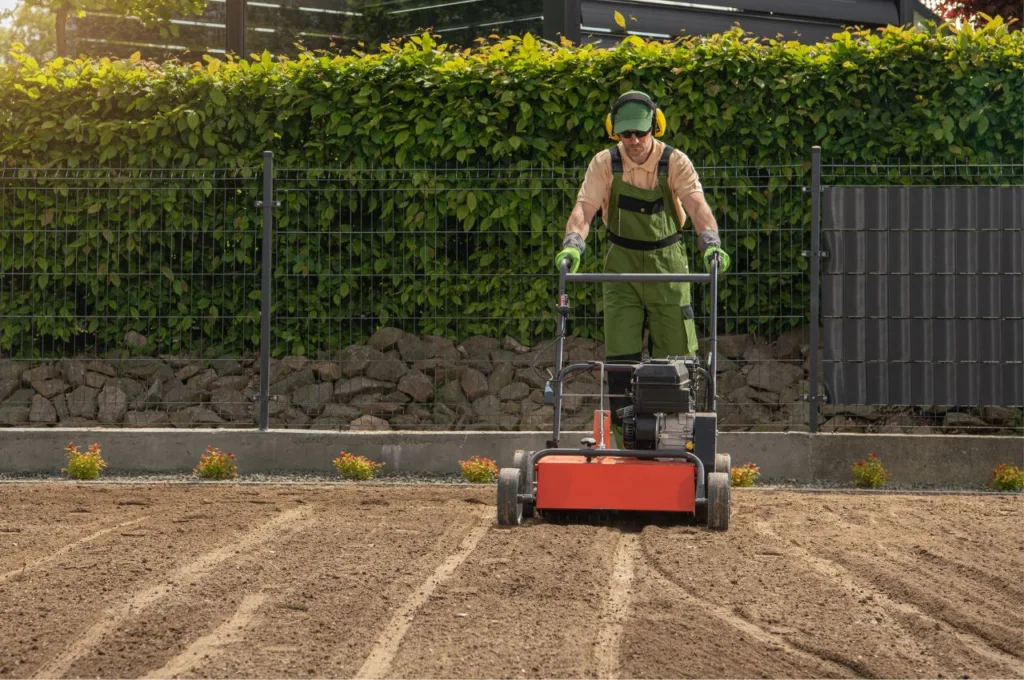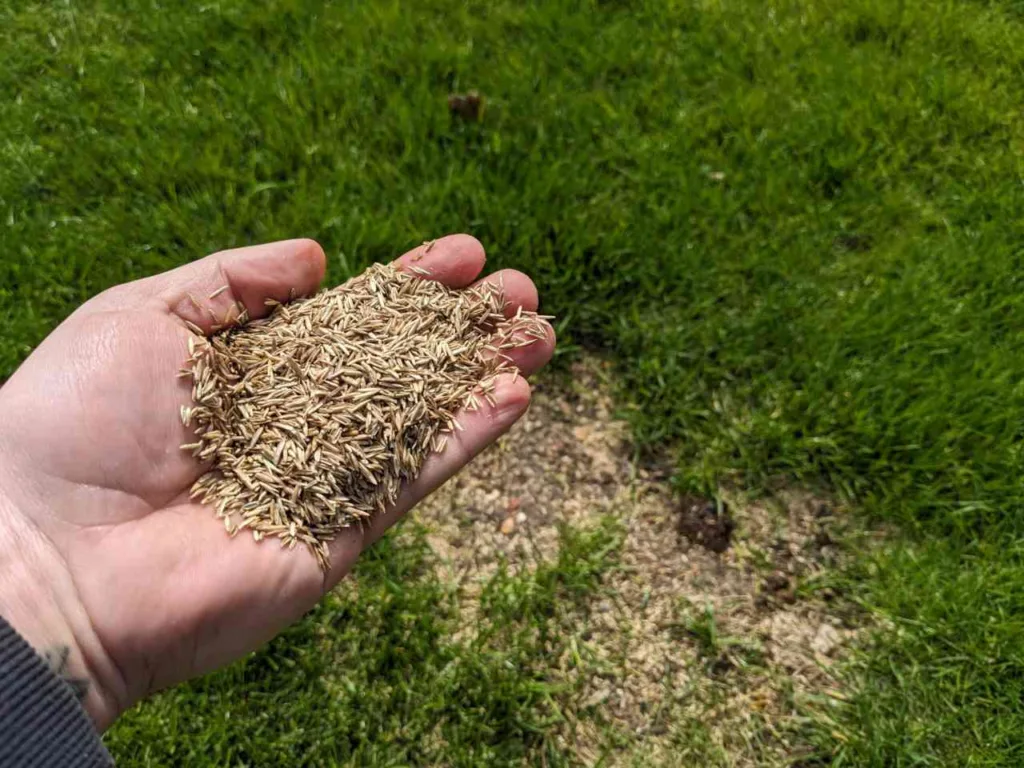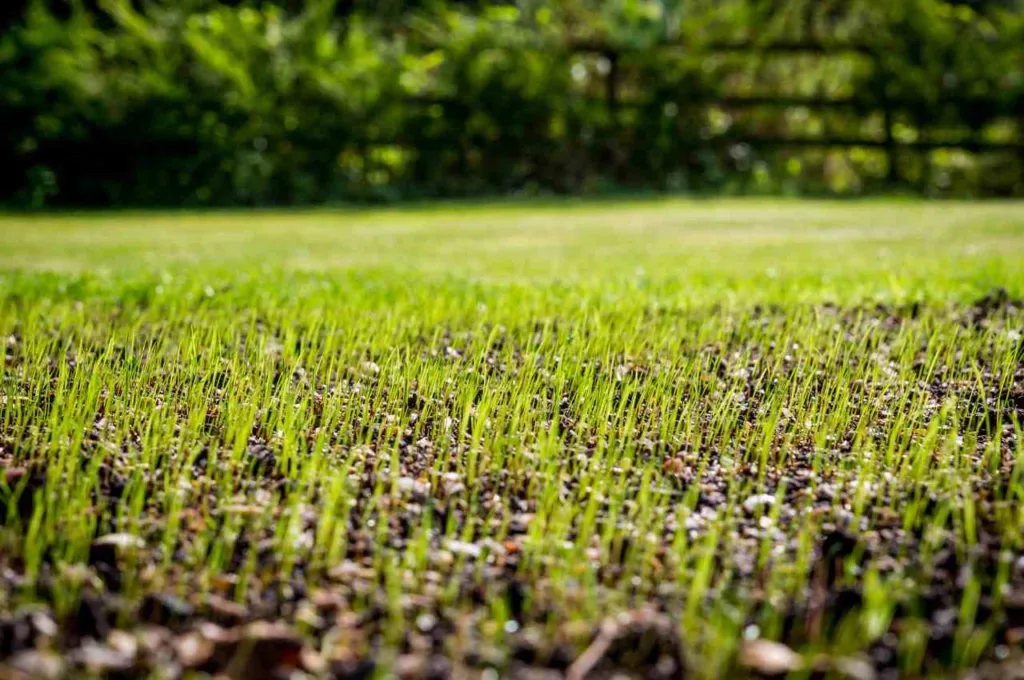If you’re looking for information on how to sow grass seed, we’ve provided all the information you need in this guide to seeding a lawn.
We’ve split this article into two sections: how to overseed a lawn (i.e. add seed to bald spots on an already established lawn) and how to seed a new lawn.
✅Key Takeaways:
Wait until early spring or autumn to plant grass seeds.
To overseed an existing lawn, prepare the area, then sow the seed with a handheld spreader, rake and level the ground, apply mulch, water the grass regularly, and apply a fertiliser.
To seed a new lawn, prepare the area, then sow the seed with a push spreader, rake and press the soil, and water the area. Wait until the grass grows to 7cm, then do the first mow and fertilise the new lawn.
Table of Contents
🤷♂️ When Should You Seed A Lawn?
In the UK, the best time to seed a lawn is spring (late March to mid-May) or early autumn (late September to early November). During these seasons, the ground is moist, and the soil temperature is optimal for plant growth, promoting seed germination – so you’ll get the best value from the seeds you sow.
🚜 How To Prepare The Ground For Grass Seed
Before you sow grass seed on your lawn, make sure to take the time to prepare the space for optimal results.
Start by clearing your lawn of any debris, rocks, or weeds that could impede germination. What happens next depends on your situation:
If you’re overseeding an existing lawn, remove any debris, thatch, or weeds from the lawn to create a clean surface, then aerate the soil to facilitate better air, water, and nutrient movement to the newly sown grass seeds.
If you’re seeding a brand new lawn, thoroughly till the soil (i.e. turn the soil) to a depth of about 10 to 15 centimetres, ensuring a loose and well-aerated texture.
You can also consider adding organic matter to the lawn surface, such as compost, to improve soil structure, introduce nutrients, and support water retention.
Finish by leveling the area with a rake, creating a smooth and even surface.
It’s tempting to skip this step and sow your grass seed straight away, but if you want the best value from your grass seed purchase, preparation is key. Preparing the ground for grass seed is a crucial step to ensure successful and healthy lawn growth.

📑 How To Overseed A Lawn: Step-By-Step
Here’s our step-by-step guide on how to overseed bare or sparse patches on your lawn:
Step 1: Prepare The Area
Start by preparing the area for sowing grass seed. This includes aerating the lawn and removing thatch and debris. (Don’t have an aerator? We recommend the Walensee Lawn Coring Aerator (< link to Amazon), or check out our complete guide to the best electric and manual aerators for UK lawns here).
Step 2: Choose The Right Seed
If you haven’t already, shop for your lawn grass seed. Look for grass seed that matches your existing lawn’s type and characteristics. Most lawns in the UK consist of a blend of cool-season grasses, including annual and perennial ryegrass, fescues, and bentgrass.
When choosing grass seed for your lawn, consider factors like sunlight exposure, climate, and foot traffic. Also make sure the seed is favourably reviewed, and buy the right quantity for your lawn size. We’ve shared our top recommendations in our guide to the best grass seed in the UK.
Step 3: Sow The Seed
Your next step is to spread the seed on the bare or sparse patches of your lawn. It’s a good idea to use a grass seed spreader (a handheld spreader like this one should be fine for spreading grass seeds in smaller areas) to ensure the seed is evenly distributed.
Follow the recommended seeding rate on the seed packaging. Apply half of the seed in one direction and the other half perpendicular to it for thorough coverage.
Step 4: Rake And Level
Once you’ve sown the seed, gently rake the seeded areas to incorporate the seeds into the soil. Don’t miss out on this step – it ensures good seed-to-soil contact, which is essential for successful germination.
You might need to level the surface afterwards. Be careful not to bury the seeds too deep – they should be around 1-2cm beneath the soil surface.
Step 5: (Optional): Apply Mulch
Your next step is to protect the area as grass seed germination takes place. A great way to retain moisture and shield the newly sown grass seeds from birds is to spread a thin layer of straw or mulch over the seeded areas.
This will also help to prevent the seeds from drying out too quickly, so you’ll have a higher success rate from your efforts.
Step 6: Water Regularly
If all has gone well so far, you should notice grass seedlings appearing around 7-10 days after sowing. But the work isn’t over yet! Don’t forget to water the overseeded areas immediately after seeding, and then keep the soil consistently moist during the germination period.
Light, frequent watering is best to prevent the soil from drying out. Ideally, water your lawn once twice per day for around 3-4 weeks. If you’ve sown your lawn during a typical wet UK summer, there may be no need to water. You don’t want to overwater the seeds – this could lead to disease or seed displacement.
Step 7: Fertilise The Grass
Around 4 to 6 weeks after germination, when the new grass is about 5 centimetres tall, treat the seeded area with a lawn feed or fertiliser to help encourage rapid, healthy growth.
Make sure to apply the fertiliser according to the manufacturer’s instructions (too much could burn the grass, undoing the results of your hard work). We’ve always had a great experience with the Miracle-Gro Water Soluble Lawn Food for supporting newly planted grass growth, or check out our guide to the best lawn feed available today for our reviews of different fertilisers for different situations.
Step 8: Maintain Carefully
By this stage, your new grass seeds should have developed into fully established grass plants, and the pressure is off.
As the new grass grows, you can gradually reduce the frequency of watering but increase the amount each time. Once the new grass reaches the height of the existing lawn, resume your regular lawn care routine, including mowing, watering, and fertilising.

🧾 How To Seed A New Lawn: Step-By-Step Our Top
Here, we’ve shared the step-by-step process of how to seed a new lawn:
Step 1: Prepare The Area
Start by preparing the area to sow the grass seed. Remove weeds, rocks, debris, and existing vegetation from the ground, and level the ground with a rake. Use a garden fork to turn and loosen the top 10-15 centimetres of soil.
Step 2: Choose The Right Seed
Next, buy the seed for your lawn. The best grass seed for a new lawn is a seed mix (containing fescues and ryegrass) because different grass types offer different benefits, helping you to grow and sustain a healthy lawn in the long term.
Step 3: Sow The Seed
Divide the lawn site into smaller sections for easier and more consistent seeding, then evenly distribute the grass seed over the soil with a seed spreader. If you have a large space to cover, we recommend a push spreader on wheels, like the Miracle-Gro Lawn Seed Drop Spreader (< Amazon link).
Apply half of the seed in one direction and the other half perpendicular to it. Make sure to follow the manufacturer’s instructions for spreading.
Step 4: Rake And Press The Soil
Once you’ve sown the seeds, gently rake the seeded area to lightly cover them with soil or mulch. This prevents the seeds from drying out and encourages faster growth.
Use a lawn roller or the back of your rake to press the soil down slightly, helping to further secure the seeds.
Step 5: Water The Area
Water the newly seeded area immediately after you’ve finished seeding. You’ll need to make sure the soil is thoroughly moist but not waterlogged, which could cause the seeds to disperse onto other parts of your lawn.
After the initial water, return to your lawn in the days following to water frequently and lightly. The grass seeds should germinate within 7-10 days (some take up to 3 weeks).
Step 6: Do The First Mow
Once the new grass reaches about 7 centimetres in height (preferably after about four weeks), mow it to a height of 5 centimetres.
You don’t want to mow the grass too early, or mow too much off the grass, or you risk pulling the grass out of the ground or stressing it and causing it to die.
Step 7: Fertilise The Grass
A good way to encourage your new lawn to grow quickly and healthily is to introduce more nutrients into the soil with a balanced, slow-release fertiliser. Aim to feed your lawn around 4-6 weeks after the seeds have germinated.
A one-time fertiliser applicaiton is more than adequate, but if you want to enjoy the lushest, greenest lawn from your efforts, continue to fertilise every few months according to the schedule recommended by the lawn feed manufacturer.
Step 8: Maintain Carefully
Continue to maintain your lawn after the initial mow and fertiliser application for optimal results.
You can gradually reduce the frequency of watering over time, especially if the weather takes over (a likely outcome in the UK!). You can then resume your regular lawn care routine, including mowing, watering, and fertilising.

🚑 Lawn Seeding Essential Aftercare
Our top three recommended lawn seeding aftercare practices are:
Water the seed evenly and regularly (but don’t overwater!). Without water, the seeds won’t germinate or grow.
Apply a light layer of compost to the nearly sown grass seed. This will keep the moisture in and protect it from the birds
Apply a balanced, slow-release fertiliser about 4-6 weeks after germination. This provides essential nutrients for healthy growth
If you’re only seeding a small area, our advice is actually to top dress with compost rather than topsoil (which is what people generally advise). This will help to hold the moisture in (which is especially important if you seed in spring before a potentially hot, dry summer).
However, if your lawn is prone to waterlogging, especially if you’re seeding in autumn, you might want to use topsoil or sandy soil. You’ll just need to water it more often.
🔍 4 Tips For Seeding A Lawn
Wondering how you can get the best results from sowing seed on your lawn? Here are our top 4 tips, based on our personal experience:
Avoid foot traffic on the seeded area for at least 4 weeks after sowing grass seed. This will prevent compacting the soil and damaging delicate young grass shoots during their germination and early growth stages.
Here’s a niche piece of advice that we’ve personally had success with! After sowing grass seed, raking it in, and top-dressing, we then put more seed on top of the compost. This means the greedy pigeons (of which there are many in the UK) eat the top, unimportant layer of seed, but are unlikely to disturb the lower seed. You might think that this would encourage birds to visit your garden, but trust us when we say that they will find your lawn after seeding anyway.
Don’t listen to the myth that says you should apply pre-germination fertiliser on your soil before you sow grass seed. The seed contains everything it needs to establish itself. However, you may require some fertiliser post-germination (once the grass is established), especially if you have poor-quality soil.
Heavy rainfall will wash grass seed away, especially if your lawn is on a hill or slope. So, don’t plant grass seed if rain is on the cards. Wait for a sunny spell before you consider seeding your lawn.
FAQ
Can you just sprinkle grass seed on grass?
Yes, you can technically just sprinkle grass seed on your grass without any prep. However, you’re unlikely to see good results, so the investment value from your purchase will be poor. A good portion of the sprinkled seed may not make contact with the earth, and without raking the seed into the ground, you’re making it easier for birds to come and eat it.
Do you plant grass seed in topsoil or lawn soil?
Topsoil and lawn soil are essentially the same and have very similar compositions. However, to answer the question, yes, you can plant grass seed straight onto lawn soil. Most people buy topsoil as extra soil to sprinkle onto the seed after sowing.
Do you wet soil before grass seed?
Yes, it’s a good idea to wet soil before planting grass seed. Moist conditions encourage the seeds to germinate quickly and provide water for the emerging roots. Just make sure that you don’t overwater, which could wash the seed away from the desired planting area.
How long does grass seed take to germinate?
Grass seed germinates within 7-10 days on average. At this stage, you should notice grass seedlings emerging from your soil. Seeds should germinate the fastest when they have access to plenty of water and nutrients from the soil, and the soil isn’t too cold (the ideal soil temperature range for grass seed in the UK is around 8-10 degrees Celcius).
Do you cover grass seed with soil?
Yes, once you’ve sown grass seed, you should cover it with a fine layer of soil or mulch to help retain moisture, keep the soil warm, and protect the seed from birds.
Will birds eat lawn seed?
Yes, birds will eat lawn seed – unfortunately, it’s inevitable. We had a bird feeder full of pumpkin seeds in our back garden for over a year that birds didn’t touch, but the moment we planted grass seed, the birds arrived. You can help protect the seed from birds by covering it with a layer of topsoil or mulch.
